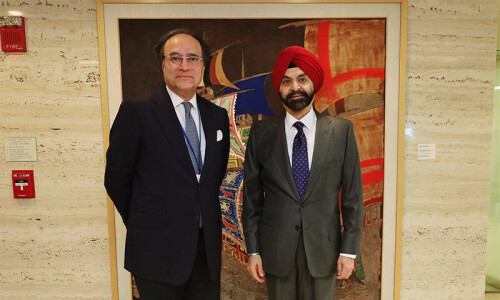The Pakistani initial public offering market is heating up. Nine companies mobilised an aggregate sum of Rs73bn from the stock market through new and secondary issues last year. This compares with the Rs4.4bn raised in the previous three years (2011-13) combined.
However, the 2014 figure may look a little swollen as it included huge offerings by the government from its holdings in state-owned enterprises.
Nevertheless, at least four new listings in as many months this year show that corporates are looking yet again at the capital market to raise money. And they have been encouraged by the investors’ enthusiastic response. The huge offerings last year were on average oversubscribed by a factor of two.
On the other hand, corporate credit offtake from banks is waning. The State Bank of Pakistan reported a 37pc drop in private sector borrowings to Rs195bn in the first nine months of this fiscal year, though possibly due to seasonal factors. That is despite the steep drop in the policy rate to 8pc from 10pc in about four months.
So are the companies turning away from banks for their credit requirements or are the banks simply a reluctant to lend?
“A bit of both,” says a former president of one of the five largest banks in the country, who asked for anonymity. He said consumer borrowing — which is a major part of banks’ credit portfolios in developed economies — is almost non-existent in Pakistan.
At least four new listings in as many months this year show that corporates are looking yet again at the capital market to raise money. And they have been encouraged by the investors’ enthusiastic response
“For instance, total mortgage financing is just 1pc of aggregate banking assets in the country, whereas it is as high as 150-200pc of banking assets in the West.” As a result, the change in interest rates does not have a profound effect on our economy, he added.
All fingers point to the banking sector’s penchant to parking funds in the high-yielding stock market. Among local participants, banks have assumed the role of major traders at the bourse.
According to Arif Habib Limited’s (AHL) ‘market strategy report’ released last Wednesday, the banking sector — which has the second-heaviest weightage of 22pc in the KSE-100 Index — posted an earnings growth of 13pc in the quarter ending March 31 (3QFY15) over the previous quarter. The sector accounted for 54pc of the overall corporate profitability.
“The solid growth in banking sector’s net profits during 3QFY15 is attributable to gains on sale of securities (exploiting the opportunity to realise massive gains from Pakistan Investment Bonds) and higher net interest income,” said AHL analyst Shahbaz Ashraf.
And banks love to place more funds in risk-free, high-return PIBs and Treasury bills than even equities. A JS Global report by Amreen Soorani last month stated that commercial banks posted overall profits of Rs158.22bn last year, up 47pc from Rs107.83bn they made a year ago.
The big five banks — HBL, MCB, UBL, NBP and ABL — saw a big rise of 31pc in their cumulative profit to Rs111.3bn. The annual reports of the big five banks show that their aggregate investments reached a huge Rs2.9trn last year. As much as 86.4pc of these were concentrated in government securities like T-bills, PIBs, eurobonds and Sukuks.
“Scheduled banks’ investment in PIBs touched a record high of Rs2.66trn in 2014, which is 3.57 times their investments in December 2013,” observed Amreen.
But does the banks’ preference to lend to the government instead of the corporate sector worry industry stalwarts?
“That will be putting the cart before the horse,” said Zubair Motiwala, a former chairman of the Sindh Board of Investment. “The government must change its attitude of lack of interest towards industry, adopt clear and consistent policies, and ensure adequate and uninterrupted supply of gas and electricity.”
He also complained that banks’ lending to the textile sector had dipped to 11pc from 30pc a decade ago, as the banks are diversifying credit to less risky businesses such as those in food, consumer goods and power sectors.
Muzzamil Aslam, CEO of Emerging Economic Research, believed that corporates’ lower fixed and working capital requirements may explain their lack of interest in seeking bank loans. Since new projects are mainly on hold, there is no requirement from that side. Meanwhile, the drop in prices of oil and other raw materials has provided companies with sufficient internal cash flows to finance much of their funding requirements.
Nasim Beg, vice chairman of Arif Habib Savings, agreed that corporates normally borrow for domestic project growth and for financing export activities. The first has been handicapped by energy constraints, while things are still sticky on the export front.
Majyd Aziz, former president of the Karachi Chamber of Commerce and Industry, asserted that the cost of bank borrowings is still high and that banks are also more stringent about their lending after the introduction of prudential regulations. Yet, he believes that cash flow is heading into real estate, stock market and to offshore destinations like Dubai.
“The money is going everywhere except into the industrial sector, since there are no incentives and too many hardships.”
And the going could not have been any easier for banks to earn fabulous returns through their risk-free investment in PIBs, he said.
On a lighter note, he added that it was perhaps a waste of money on the part of banks to construct such big and lavish branches. “For the type of work they do, two people in each branch should be more than sufficient.”
Published in Dawn, Economic & Business, May 11th , 2015
On a mobile phone? Get the Dawn Mobile App: Apple Store | Google Play
















































Dear visitor, the comments section is undergoing an overhaul and will return soon.